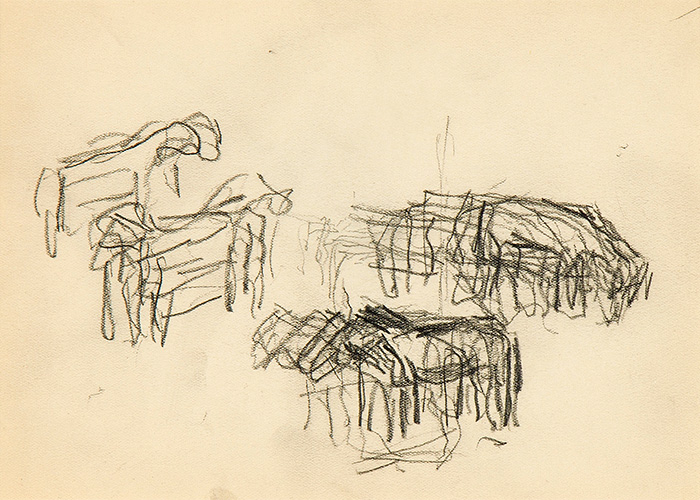22 important landscape paintings by Carl Kylberg
Carl Kylberg (Fridene, Västergötland, 1878–1952 Stockholm) belongs to one of the 20th centurys foremost swedish draftsmen. Outside of academic circles, he’s primarily known for his oil paintings today. His drawings have not been shown publicly as often, and when they appear on the market, it’s usually in the form of caricatures and illustrations from children’s books. All of the drawings in this auction depict landscapes. They have until recently been kept in the Kylberg family.
The majority of Kylbergs well-known landscape drawings are found in sketchbooks, making them relatively small. The motifs are mainly sea and coastal landscapes and fishing villages found in Skåne, where Kylberg spent his summers 1917–1919, and Denmark, where he spent his summers after marrying gymnastics manager Ruth Liljeblad 1921. Until 1930 they spent their time in Helsingör, 1931–37 in Honbæk and after that in Ellekilde at Skällands northern coast. Kylbergs art is characterized by dissolving shapes and colour as an expression of emotion. The dissolving figures – a result of the sunlight's disrupting effect on its surroundings – come to their full rights in his drawings.
Read more
The majority of Kylbergs well-known landscape drawings are found in sketchbooks, making them relatively small. The motifs are mainly sea and coastal landscapes and fishing villages found in Skåne, where Kylberg spent his summers 1917–1919, and Denmark, where he spent his summers after marrying gymnastics manager Ruth Liljeblad 1921. Until 1930 they spent their time in Helsingör, 1931–37 in Honbæk and after that in Ellekilde at Skällands northern coast. Kylbergs art is characterized by dissolving shapes and colour as an expression of emotion. The dissolving figures – a result of the sunlight's disrupting effect on its surroundings – come to their full rights in his drawings.
Carl Kylberg is one of few modern Swedish 20th-century artists who has gained international interest. 1939 Kylberg showed his art at the Golden Gate Exhibition in San Fransisco, 1945 in a Swedish collective exhibition in London, and in Paris 1946, he was the first Nordic artist who was invited to arrange a solo show at Musée Nationale d’Art Moderne in Paris 1951, which the following year was moved to Palais des Beaux-Arts in Brussels. Due to illness, Kylberg couldn’t attend the Paris opening himself, and before it was moved to Brussels, he had passed away. A collection in memory of him was shown at the Biennale in Venice in 1952. In 1958 an exhibition of his work was held at Musée des Beaux-Arts in Liège, and in 1961, several of his works were part of the Biennale in Sao Paulo.
Carl Kylberg was disputed in Sweden, where neither average citizens nor artists could understand his art, where the visionary and the dissolving shapes prevailed over time. As his success grew, so did the resistance, culminating when Nationalmuseum bought his painting “Uppbrottet”, 1935, during his retrospective show at Konstakademien 1937. According to the museum’s statues at the time, any purchase of modern Swedish art should be submitted to His Royal highnesses examination. This rule had for a long time been entirely formal, but the ecclesiastic minister Arthur Engberg used his veto against the purchase. The actress Tora Teje then bought and donated the painting to the museum, who could decide whether they wanted to keep gifts. In the lively press discussion that followed, Engberg claimed that the painting was unfinished in its appearance and peculiar as a whole. He was supported by, amongst others, Isaac Grünewald, who declared that there must be a balance between colour and shape and that if “an artist knowingly rejects either one, then it must be declared bankrupt”. How the topic of the purchase was treated aroused concern for the future of the stately culture politics, as Engberg’s veto coincided with nazi Germany’s persecution of “entartete Kunst”. While the press battle lasted, Kylberg stayed mainly in Denmark, where his art was generally appreciated. As Kylbergs opponents claimed that he couldn’t draw, the museum director at Statens Museum for Kunst Leo Swane arranged a special exhibition of Kylbergs drawings and aquarelles.
The same year a large exhibition of his works was held at Konstakademien in Stockholm. Kylberg was 1948 appointed honorary member at Konstakademien in Copenhagen; he never received a similar honour in Sweden. In 1950 Moderna Museet acquired several of Kylbergs landscape drawings. 1974 they received several more of his landscapes as a gift from His Royal Highness Gustav VI Adolf according to his testament. The same year they also received a number from Ann Mari Runnqvist, mother of the well-known art dealer Jan Runnqvist. Sveriges allmänna Konstförening held a substantial Memorial exhibition of Carl Kylbergs work, containing 203 items, at Liljevalchs 1954. Apart from a few aquarelle sketches for children’s books, all items were oil paintings. It wasn’t until the Svensk-Franska Konstgalleriets exhibition “Carl Kylberg – Människor, hav, landskap” in 1964 that his drawing skills were acknowledged in Sweden. Out of the approximately 80 items exhibited, around 50 were aquarelles and drawings. And it wasn’t until 1982, when several of Kylbergs drawings were transferred from the Tessin Institute in Paris, he became represented in the drawing collection at Nationalmuseum.












































